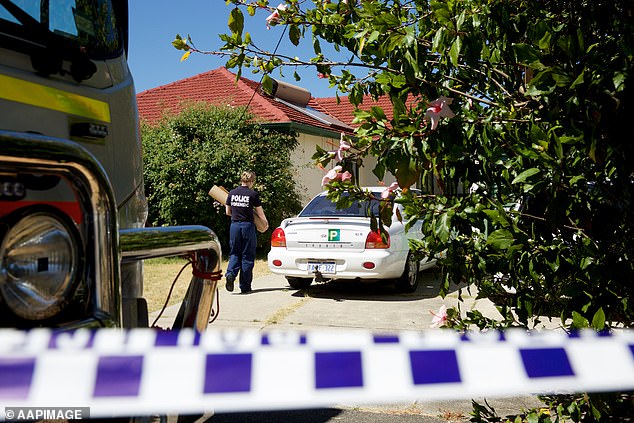The policeman who kicked down the door when police arrested Claremont serial killer Bradley Robert Edwards has described the sex fiend’s shocking reaction when he was finally caught, calmly asking officers: “So what’s this all about?”
Todd Bowler was a member of the Western Australian Tactical Response Group when he was called to participate in the arrest of Edwards 20 years after his killing spree began.
Edwards was the prime suspect in the deaths of Jane Rimmer, Ciara Glennon and Sarah Spiers when police surrounded his home in Kewdale, east Perth, on December 22, 2016.
The three girls had disappeared from Claremont, in the west of the city, between January 1996 and March 1997. Mrs Spiers’ body was never found.
Mr Bowler was a general duties officer when the women disappeared and had been driving around Claremont looking for suspicious vehicles at the time.
When it came time to question former Telstra technician Edwards two decades later, Mr Bowler was willing to participate.
“It was a pretty quiet thing when it first came out because it was so well known and detectives didn’t want the fact that they had found a suspect to leak out,” she told the Crime Insiders podcast.
Mr Bowler said the operation was planned so that Edwards would be knocked down without having time to resist or destroy any evidence that might be in his home.
The policeman who kicked down the door when police arrested Claremont serial killer Bradley Robert Edwards (above) described the sex fiend’s calm reaction when he was finally caught.
“We had to find a way to do it seamlessly and keep all the evidence intact, if there was any left after all these years,” Mr Bowler said.
“We went out that morning and sat in front of his house, quite far away in the bush, and got a surveillance team to take a look at the house.”
Surveillance equipment did not detect any movement inside the home, so police could not determine whether Edwards was inside or not.
“For obvious reasons, the police commissioners and senior officers wanted this guy arrested as soon as possible,” Mr Bowler said.
“Because leaving a known serial killer on the street would be a bad thing, so we had to make a decision at some point.”
Having seen no sign of Edwards since dawn, it was decided that the best way to establish the killer’s location was to see if they could lure him out.
“We ended up coming up with a plan where an undercover surveillance officer went to knock on his front door and Bradley Edwards opened the front door,” Bowler said.

Bradley Edwards was the prime suspect in the deaths of Jane Rimmer, Ciara Glennon (above) and Sarah Spiers when police surrounded their east Perth home on December 22, 2016.
‘The undercover guy basically said, “I just saw some guys messing around with the car out front. You might want to check it out.”
‘Bradley Edwards said, “Yeah, thanks for letting me know,” and he came out, checked his car doors and stuff, and went back into the house.
“A couple of minutes after that, we organized our team and went inside.”
Mr Bowler’s job was to breach the building through the main door.
“I destroyed the front door,” he said. “The front door opened like a bar door.
‘The top half broke and the bottom half stayed there. It was an old wooden door, so it just opened. So I ended up dismantling it into small pieces of wood.
“We got through there pretty quickly and then we held him at gunpoint in the hallway, pretty much right at the front door.”
Mr Bowler said that when Edwards realised police had broken into the house, “he was on the floor on the hallway carpet, tied up face down”.

Retired police officer Todd Bowler said the operation to arrest Edwards was planned so he wouldn’t have time to resist or destroy any evidence that might be in his home (above).
So far, everything had gone according to plan, as other officers came in from the back and cleared every room in the house.
Mr Bowler said most offenders were “not very verbal” when TRG members pointed guns at them, but sometimes “became brave again” once they had left.
Edwards’ reaction, particularly for a person who had never been arrested at gunpoint, was unlike anything Bowler had seen before.
“He sat on the mat for probably four or five minutes while we were standing over him with guns, just making sure he didn’t do anything,” Bowler told the podcast.
And then he raised his head and said, “So what’s this all about?”
‘We told him: “Mate, the detectives will be here soon. Don’t make any noise, they will call you when they arrive.”
“He said, ‘That’s fair,’ and laid his head back on the carpet.”
Mr Bowler said Edwards’ heart rate did not appear to exceed 50 beats per minute.
“He was very quiet and very quirky in that way,” she told the podcast.

Todd Bowler (above) was a member of Western Australia’s Tactical Response Group when he was called in to help arrest Edwards 20 years after his killing spree began.
The next day, Edwards was charged with the murders of Ms. Rimmer and Ms. Glennon. He was charged with Ms Spiers’ murder in February 2018.
In October 2019, he pleaded guilty to five further charges relating to sexual attacks on an 18-year-old woman in Huntingdale in 1988 and a 17-year-old boy at Karrakatta Cemetery in 1995.
In June 2020, after a seven-month trial, Judge Stephen Hill found Edwards guilty of murdering Rimmer and Glennon, but not guilty of murdering Spiers.
Judge Hill said it was more likely than not that Edwards also murdered Spiers and in December 2020 sentenced him to life in prison with a minimum term of 40 years.
Mr Bowler, who left the police force shortly after helping to arrest Edwards, said it had been satisfying to end his service by taking down the Claremont serial killer.
“I would be surprised if anyone would be willing to give him parole, because you’d have to put your name on that case,” he said. “So I don’t think he’ll get out.”
(tags to translate)dailymail


